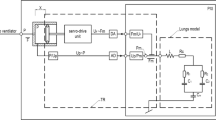Abstract
The mechanical respiration of intubated patients is a process which is influenced by many parameters and, through its many interactions, is extremely complex. Taken by itself the logical analysis of this complexity is extraordinarily difficult and leads very often to false conclusions.
For that reason computer simulation of complex systems by means of the computer is an important tool in the analysis of these processes. Required is a model which describes the actual behavior of the system. However, it should not be overlooked that a model always describes only a portion of reality.
Models having exclusively to do with ventilation mechanics or with gas exchange cannot simulate the interactions between the two. To accomplish this purpose, an improved model is necessary, including both partial processes and thereby capturing the complexity of the system.
Accordingly, both ventilation mechanics and gas exchange have been integrated equally into the newly developed model for the simulation program Simu Vent. The core of the program builds a functional multicompartment model of the lungs and considers the partial processes ventilation mechanics, gas transport, gas mixing and gas exchange. Further considered are the respirator, blood circulation and peripheral compartments. The program runs under a graphical user interface, allowing its easy use. Responsible for this ease is the user's ability to interact with the program while simulation is in progress and the specially designed graphic screen mask.
Comparing measured with simulated values demonstrated that the measured curve can be simulated with minimal error. Furthermore, the multicompartment model describes disruptions in distribution.
Simu Vent's application is especially well advised in the description and analysis of the theoretical fundamentals of mechanical respiration. This aspect is meaningful above all in education and research, rendering these two the model's main areas of use.
Similar content being viewed by others
References
Rennert P. (Hrsg.): Physik. 1. Aufl. Leipzig: Bibliographisches Institut, 1986: S. 622.
Kelman GR. Digital computer subroutine for the conversion of oxygen tension into saturation. J Appl Physiol 1966; 21: 1375–6.
Kelman GR. Calculation of certain indices of cardiopulmonary function using a digital computer. Resp Physiol 1966; 1: 335–43.
West John B. Bioengineering Aspects of the Lung. New York: Marcel Dekker Inc., 1977.
Dickinson, CJ. A Computer Model of Human Respiration. Lancaster: MTP Press Limited, St. Leonard's House, 1977.
Author information
Authors and Affiliations
Rights and permissions
About this article
Cite this article
Winkler, T., Krause, A. & Kaiser, S. Simulation of mechanical respiration using a multicompartment model for ventilation mechanics and gas exchange. J Clin Monitor Comput 12, 231–239 (1995). https://doi.org/10.1007/BF01207204
Accepted:
Issue Date:
DOI: https://doi.org/10.1007/BF01207204




